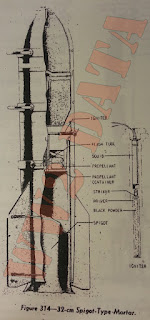Japanese Explosive Ordnance: Army and Navy Ammunition
We finish off the last of the mortar rounds, and thus complete the list of explosive ordnance for the Imperial Japanese Army. Technically, it's not the end as there is another 30 or so pages on the all the various Fuzes they used which I'll skipping over it unless there's a particular demand for it.
Type 2 120mm High Explosive Mortar
Weight of complete round: 26.5 lbs
Weight of main charge: 6 lbs
Explosive components:
-Main Charge: TNT
-Booster: RDX and wax
Overall length (w/o fuze): 22.5 inches
Maximum diameter at bourrelet: 120mm
Maximum diameter at tail fins: 120mm
Color:
Black overall with a red tip and a yellow band forward of the bourrelet
Fuzing:
Type 100 instantaneous short delay mortar fuze
Used in:
Type 2 120mm Mortar
Description:
The body section of this shell is similar to that of the standard Army finned mortar types but the tail fin section resembles that of the Navy 81mm H.E. The 12 fins are welded to the propellant tube which is welded to the base of the body. The forward end of the tube has 42 escape ports arranged in 6 rows to allow the flash to pass from the primary cartridge to the propellant increments. The initial charge is contained in a cardboard case which fits inside the propellant tube and is held in place by a steel plug fitted with the primer cap. The main propelling charge is contained in 6 doughnut shaped silk bags which are split so that they can be slipped around the propellant tube above the tail fins and over the flash ports.
Remarks:
A variation of this shell has been found with the tail section threaded into the body and secured by a pin instead of being welded to the body.
Type 96 150mm High Explosive Mortar
Weight of complete round: 58.06 lbs
Weight of main charge: 12.9 lbs
Explosive components:
-Main Charge: TNT
-Booster: Picric
-Propellant:
--Nitrocellulose and graphite: 58%
--Nitroglycerine: 7.1%
--Dinitrotoluene: 25.7%
--Diphenylamine: 0.5%
--Potassium Nitrate: 8.7%
Overall length (w/o fuze): 28.75 inches
Length of fin assembly: 7.81 inches
Maximum diameter at bourrelet: 150mm
Maximum diameter at tail fins: 149mm
Color:
Black overall with a red tip, a yellow band below the bourrelet, and a white band before the tail fin assembly.
Fuzing:
Type 93 instantaneous short delay mortar fuze
Used in:
Type 96 150mm smoothbore mortar
Description:
The construction of this shell is similar to that of the Type 97 81mm H.E. mortar shell.
Type 97 150mm High Explosive Mortar
Weight of complete round: 43.5 lbs
Weight of main charge: 8.98 lbs
Explosive components:
-Main Charge: TNT
-Booster: RDX and wax
-Propellant:
--Nitrocellulose and graphite: 58%
--Nitroglycerine: 7.1%
--Dinitrotoluene: 25.7%
--Diphenylamine: 0.5%
--Potassium Nitrate: 8.7%
Overall length (w/o fuze): 23.7 inches
Length of tail fin assembly: 6.7
Maximum diameter at bourrelet: 120mm
Maximum diameter at tail fins: 120mm
Color:
Black overall with a red nose tip and a yellow band before the bourrelet.
Fuzing:
Type 100 instantaneous short delay mortar fuze
Used in:
Type 97 150mm smoothbore mortar
Description:
Except for its shorter size, this projectile is similar in construction to the Type 96 H.E. long round.
Note. By long round, I believe they meant the previous entry.
32cm Spigot Type Mortar
Weight of complete round: 737 lbs
Weight of nose section, loaded: 172 lbs
Weight of center section, loaded: 215 lbs
Weight of tail section, loaded: 350 lbs
Weight of main charge: 103 lbs
Explosive components:
-Main charge: TNT
-Booster: P.E.T.N.
-Propellant: Black powder and nitrocellulose
Overall length (w/o fuze): 61 inches
Lenght of nose section (less threaded portion): 13.75 inches
Length of center section (less threaded portion): 10.92 inches
Length of tail section (less threaded portion): 36.31 inches
Body diameter: 320mm
Inside diameter of tail section: 257mm
Maximum diameter of tail fins: 641mm
Length of tail fins: 21.4 inches
Color:
The projectile is painted black overall with a red nose tip and a yellow band around the rear of the nose section
Fuzing:
Type 98 interior fuze
Used in:
Special spigot-type projector
Description:
The projectile, which resembles a bomb, is made in three parts:
-The nose section is ogival in shape and is externally threaded at its base to screw into the center section and is internally threaded to receive a steel base plate. It has a booster cup fitted with a fuze adapter screwed into the nose.
-The center section is a short cylinder, solid on the base and threaded externally to screw into the tail section. It is closed at the forward end, with a steel plate having a fuze adapter ring, fitted with a booster cup, welded in its center.
-The tail section screws onto the center section and has a gradual taper toward the rear from a point 14.5 inches below the forward end. It is hollowed out to fit over the projector tub. Four sheet-steel tail fins, each braced by two stabilizing wires, are welded to the tail section.
For convenience in handling and assembling, steel bands, each fitted with two double handles, are provided. Before the firing of the projectile, the carrying bands are removed. The propellant charge is place in a brass pot which fits into the recessed potion of the projector tube. The charge is contained in a cardboard container having a brass flash tube passing through its vertical axis, through the brass pot, and being screwed into the spigot. There is a drilled and tapped hole near the forward end of the tail section of the projectile into which the igniter tube screws. When in position, the end of the igniter tube is in close proximity to the end of the brass flash tube which leads into the propellant charge.




No comments:
Post a Comment